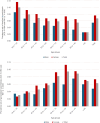Epidemiology and health care of hyperhidrosis in Germany: claims data analysis
- PMID: 39134433
- PMCID: PMC11331909
- DOI: 10.1136/bmjopen-2024-085862
Epidemiology and health care of hyperhidrosis in Germany: claims data analysis
Abstract
Background and objectives: Data on the population-based epidemiology of hyperhidrosis (HH) are scarce. This study investigated the epidemiology and healthcare of HH in Germany.
Design and setting: Claims data of adult persons insured by a German statutory health insurance (DAK-Gesundheit) between 2016 and 2020 were analysed. Included were persons aged 18 years and older with a diagnosis of HH (confirmed inpatient or outpatient diagnosis in the observation year) who were continuously insured. Following outcomes were measured: prevalence and incidence rates, severity of hyperhidrosis and inpatient and outpatient care by a group of specialists.
Results: In 2020, 0.70% of insured adults were confirmed to have HH (mean age 59.5 years, SD 18.9, 61.6% female), with 9.24% having a 'localised' form, 8.65% a 'generalised' form and 84.80% an 'unspecified' form. 0.04% of the total population had a severe form. The incidence was 0.35%. Localised HH was more common in younger age groups (18 to <30 years), while older age groups (70 to <80 years) were significantly more likely to suffer from generalised HH. Systemic anticholinergics were used in 4.55%, and botulinum toxin injection therapy in 0.81%. General practitioners were most frequently involved in care. Inpatient stays due to HH were very rare, with 0.14% in 2019 and 0.04% in 2020.
Conclusion: Multisource data analysis connecting primary and secondary data will be needed for a complete picture of the healthcare and epidemiology of HH.
Keywords: Dermatological epidemiology; Health Services; Quality in health care.
© Author(s) (or their employer(s)) 2024. Re-use permitted under CC BY-NC. No commercial re-use. See rights and permissions. Published by BMJ.
Conflict of interest statement
Competing interests: None declared.
Figures




Similar articles
-
Epidemiology of hyperhidrosis in 2 population-based health care databases.J Am Acad Dermatol. 2018 Feb;78(2):358-362. doi: 10.1016/j.jaad.2017.10.004. Epub 2017 Oct 6. J Am Acad Dermatol. 2018. PMID: 28993234
-
[Secondary data analysis of the prevalence of alcohol dependence (F10.2) in Germany].Dtsch Med Wochenschr. 2014 Nov;139(45):2285-9. doi: 10.1055/s-0034-1387353. Epub 2014 Oct 28. Dtsch Med Wochenschr. 2014. PMID: 25350241 German.
-
Hyperhidrosis Prevalence and Demographical Characteristics in Dermatology Outpatients in Shanghai and Vancouver.PLoS One. 2016 Apr 22;11(4):e0153719. doi: 10.1371/journal.pone.0153719. eCollection 2016. PLoS One. 2016. PMID: 27105064 Free PMC article.
-
The etiology, diagnosis, and management of hyperhidrosis: A comprehensive review: Therapeutic options.J Am Acad Dermatol. 2019 Sep;81(3):669-680. doi: 10.1016/j.jaad.2018.11.066. Epub 2019 Jan 31. J Am Acad Dermatol. 2019. PMID: 30710603 Review.
-
Primary focal hyperhidrosis: scope of the problem.Cutis. 2007 May;79(5 Suppl):5-17. Cutis. 2007. PMID: 17596096 Review.
References
-
- Weber A, Heger S, Sinkgraven R, et al. Psychosocial aspects of patients with focal hyperhidrosis. Marked reduction of social phobia, anxiety and depression and increased quality of life after treatment with botulinum toxin A. Br J Dermatol. 2005;152:342–5. doi: 10.1111/j.1365-2133.2004.06334.x. - DOI - PubMed
Publication types
MeSH terms
Substances
LinkOut - more resources
Full Text Sources
Miscellaneous
